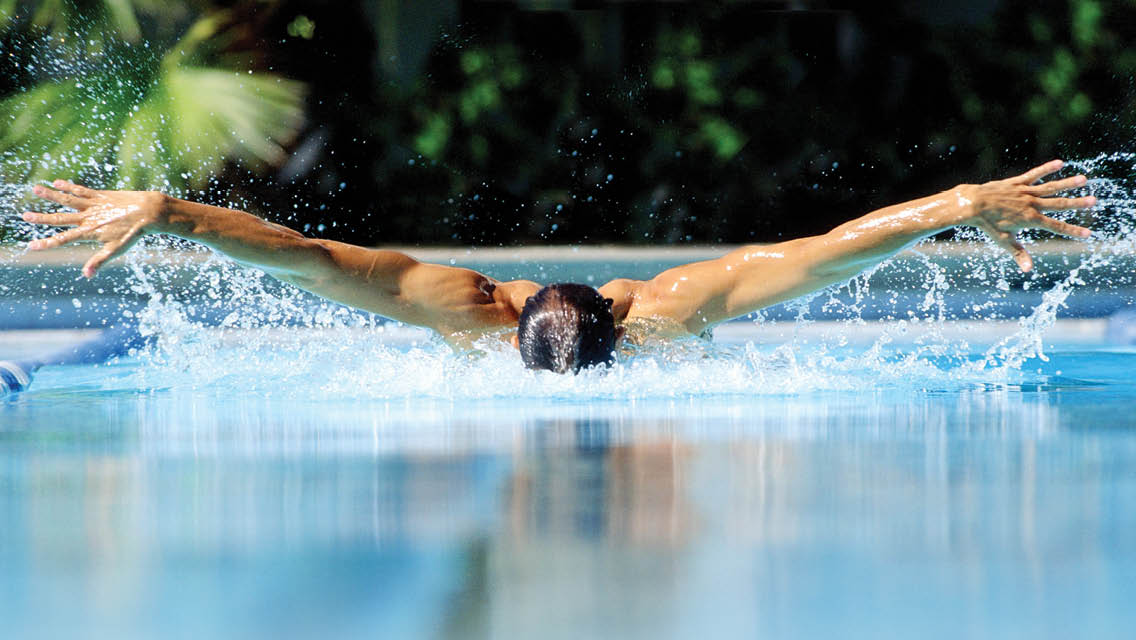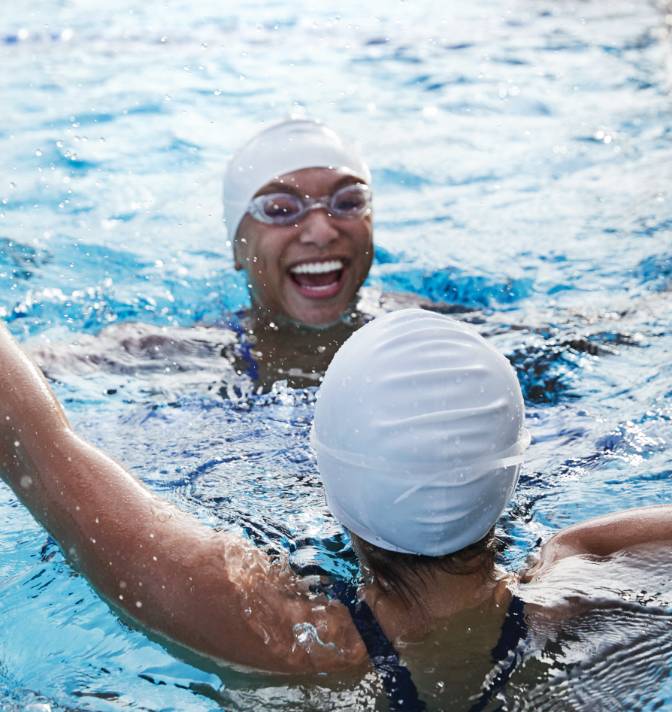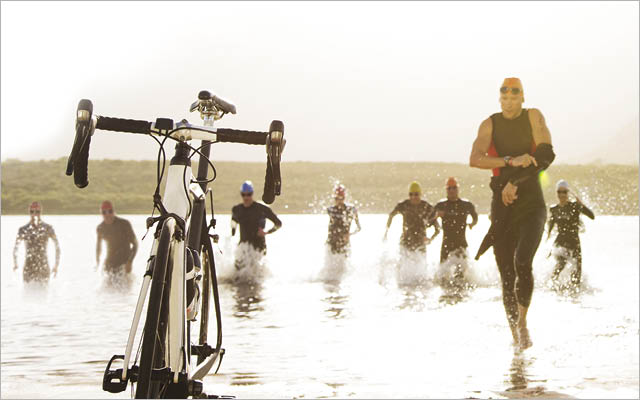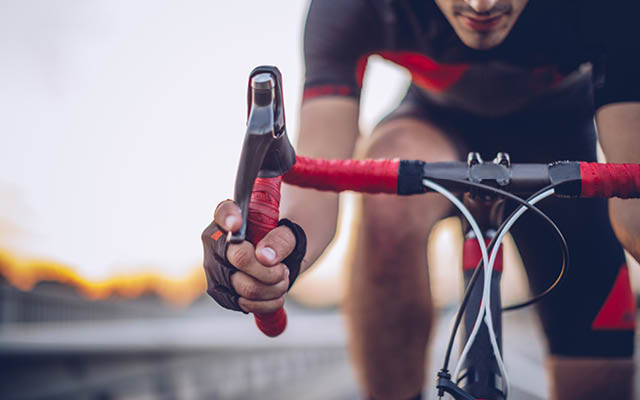ARTICLE SHORTCUTS
The Science of Swimming | Stroke Analysis | Balanced Breathing | Triathlon Practice | What to Wear
Thanks to childhood swimming lessons, I thought I could swim. My confidence lasted until I attended an adult, or masters, swim class about 10 years ago, where I was proven oh-so-very wrong.
The instructor asked me to swim to the opposite end of the 25-yard-long pool, and even though I was in killer shape — running and racing distances from 5K to marathon — my arms were burning and I was gasping for air by the time I reached the wall. In my first triathlon two months later, I didn’t fare much better. I felt inadequate as a swimmer, unnerved as other competitors passed me in the first few minutes of the race. Stroke efficiency was an afterthought, and so, for that matter, was finishing the event. I just wanted to survive the swim.
The Science of Swimming
The difference between me swimming 100 meters in 1 minute and 45 seconds and 2004 Olympic gold medalist Michael Phelps completing the same distance in less than 50 seconds is just as much about physics as it is about speed. “Forward movement in swimming deals with propulsion (a positive force) and drag (a negative force),” explains Scott Rabalais, vice president of the nonprofit United States Masters Swimming. A good swimmer can create propulsion without much drag.
Anne Wilson, a swim and triathlon coach who runs a Phoenix-based masters program designed for athletes who are inexperienced swimmers, breaks it down into numbers. “Velocity through the water is equal to your stroke length multiplied by your stroke rate,” she explains. “Stroke length is the distance your body travels during a single stroke cycle. Stroke rate is how fast you complete a single stroke cycle.”
If you want to see gains in speed you’ll have to improve the stroke-length side of the equation.
You can increase your velocity in the pool by increasing your stroke length or your stroke rate. “Stroke rate is the propulsion part of the equation,” notes Wilson, “and it relies heavily on fitness and training. Conditioning will determine how fast you can turn over your arms and for how long.” The faster you churn, though, the more turbulence you create, making the water more difficult to move through.
“Most swimmers put too much emphasis on stroke rate,” asserts Wilson. If you want to see gains in speed, she says, you’ll have to improve the stroke-length side of the equation. By reducing the number of strokes you take per pool length, you’ll increase the distance you travel per stroke cycle, thus becoming more efficient and expending less energy. “When you work on reducing the number of strokes you take, you’re actually reducing drag and becoming more slippery in the water,” Wilson says.
Stroke Analysis
Let’s face it, though: Humans are not amphibious creatures. Like oil, we don’t mix well with water. “We’re not natural swimmers,” says Rabalais, who has been swimming for 36 years and works as a coach in Savannah, Ga. “Water is a highly resistive medium, so we have to do unusual things to move through it.”
The ability to float goes a long way. Couple that with an efficient stroke and kick and you’ll feel as confident as a salmon nosing upstream. A few tips:
1. Start with proper body position. You should be able to draw a straight line from the back of the head, across the neck and down the spine to the hips. “The head determines what the rest of the body does,” Wilson says. Look directly at the bottom of the pool so water flows over the back of your head. “Many people lift their chins, which causes their hips and legs to submerge,” she explains. “Practice lowering your chin so your neck is long and relaxed. If swimmers could do this one thing correctly, the majority of the drag they create would be eliminated.”
2. Rotate your body as if on an axis. Swimming on your side, rather than flat on your stomach, means you have less mass in the water. This is when core body strength comes in handy. Olympic gold medal swimmer Tom Malchow recommends that swimmers keep their abs tight. “A lot of people swim like a spaghetti noodle — their front half isn’t connected to their back half,” he says. “You want to be rigid like a pencil.” That rigidity, he says, helps you spin on an imaginary axis.
3. Keep Your Elbows High. After pushing through the water with your hands, draw your elbows up and away from the water. With each new stroke, reach out as far ahead of you as possible before submerging your hand.
4. Develop a flexible kick. “Most of us don’t have good leg or ankle flexibility,” Rabalais says. “Our feet are developed at 90-degree angles, and in the pool, that angle encourages our legs to sink. For better buoyancy, think ‘fast feet, floppy ankles.’”
Malchow recommends working on one swim skill at a time. Focusing on too much at once can lead to frustration and fatigue. He says it’s also important to watch good swimmers and have a good swimmer or a coach watch you. “What you think you’re doing and what you’re actually doing may be two totally different things,” he says. “Sometimes the simplest change will make you more efficient.”
Balanced Breathing
One challenge for swimmers is learning to breathe “bilaterally,” or on both sides (see “Breathing Tips for Swimming” for more). One might argue it’s best to get oxygen however you can, but breathing to only one side can waste energy and skew your direction. It’s also impractical. “When swimming in open water, if the swells happen to come from the right and you only know how to breathe on the right, you won’t have a very good open-water-swimming experience,” Wilson says. Not only can breathing bilaterally help you avoid swallowing mouthfuls of water, but it’s also helpful for sighting and staying oriented in a large group, like the crowd in the water at a triathlon.
Bilateral breathing consists of taking a breath, followed by two arm strokes, and a breath on the other side. But if you need to breathe more often (such as at the start of a race), you can do so and still keep your breathing “balanced.” To do this, take two or three consecutive breaths on one side before taking the strokes to get you to the other side. Take the same number of breaths on the other side before switching again.
The most important part about breathing (aside from taking in air instead of water) is to not lift your head.
The most important part about breathing (aside from taking in air instead of water) is to not lift your head. “This immediately submerges the hips and legs, creating huge amounts of drag,” Wilson says. To keep your head aligned, return to the imaginary axis running through the top of your head and down the center of your body. “Your head can only rotate on the axis — no lifting of the chin allowed,” says Wilson. “By keeping your head in the water, you’ll reduce drag.”
Triathlon Practice
One of the best ways to become a better swimmer is to enter a race. “It’s the only way to find out what we’re capable of doing at the highest level,” Rabalais says. “It behooves anyone to get into a meet and practice swimming fast.”
While a swim meet is an excellent way to become more accustomed to competition, open-water racing is a different sort of challenge, and a triathlon swim more different still. Rabalais explains: “A triathlon swim is 20 percent or less of the whole competition, and since it’s first, you need to use your energy wisely.” You don’t worry about the start and turns as much as you would in a meet, he adds. “In a triathlon swim, pacing strategy, position and navigation are of primary importance.”
Nonetheless, you can prepare for a triathlon swim in a pool. “Some masters programs will pile several swimmers in one lane and have them push off at the same time,” Wilson says. “This is a great way to experience the bumping of elbows and splashing of feet in a mass start.”
Pace-line drills provide good practice for drafting. Swimmers in the same lane push off immediately after each other and purposely touch the swimmer’s feet in front of them. This will make you more comfortable with drafting, which can save up to 15 percent of your energy. “When you draft in a race, you don’t actually have to touch the person in front of you: Just stay a couple of feet behind them,” Wilson says.
Malchow, who returned from his third Olympic Games in 2004, believes the learning curve with swimming never ends. “I’m still learning things about how to race and how to improve,” he says.
I know what he means: My own swimming skills are much better than what they were in that initial masters class 10 years ago. Yes, I still have days when I feel my strokes are dragging. But more often than not, in a competition, I can swim with greater speed and confidence. And I still have plenty to learn.
What to Wear
Our bodies naturally create drag in the water, but we can make matters worse by wearing the wrong swimsuit. “Loose-fitting surf shorts would not be the best choice for a swimmer hoping for efficiency,” says Phoenix-based swim coach Anne Wilson. Keep suits snug and forgo anything with ruffles, bows or other accessories. Even your hair creates drag (that’s why many swimmers shave their body hair). Make your head hydrodynamic by wearing a swim cap.
Before you buy goggles, try them on in the store. “The fit of your goggles may be one of the tougher things to nail down, because the bony structures in each person’s face are so different,” Wilson says. “It just takes time and patience to find that right brand sometimes.” Consider buying tinted goggles, she says, which will significantly reduce glare when you’re swimming in bright sunshine.
This article has been updated. It was originally published online on May 1, 2005.





This Post Has 0 Comments